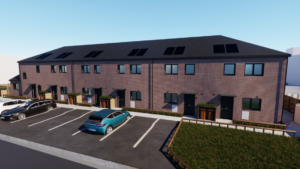Time for a hutting revival in Scotland?
 Dotted around Scotland are small groups of huts – the remnants of the 1920’s hutting movement which allowed industrial workers to enjoy time in nature with their families. Karen Grant from the Thousand Huts campaign believes that today Scotland needs huts more than ever.
Dotted around Scotland are small groups of huts – the remnants of the 1920’s hutting movement which allowed industrial workers to enjoy time in nature with their families. Karen Grant from the Thousand Huts campaign believes that today Scotland needs huts more than ever.
Simple, rustic buildings have long been central to Scotland’s cultural riches. From shielings to mountain bothies and shepherds’ huts, they have played a crucial role as lively, temporary containers for music, poetry, learning, celebration, retreat, work and family time in Scotland’s countryside.
These have been immortalised in artworks as diverse as Martyn Bennett’s seminal album ‘Bothy Culture’ and the Broons’ famous but’n’ben.
Today, few people know that Scotland had a strong working class hutting movement that was very active until the 1950s. The largest and best-known example of this is at Carbeth, just north of Glasgow, where over 140 huts continue to be occupied by a thriving community. The huts are not permanent residences, rather they provide intermittent, affordable accommodation for people who historically tended to come from the industrial areas of Clydebank and Maryhill in Glasgow.
In 2013, the Carbeth Hutters made hutting history by succeeding in buying the land where their huts are sited. Carbeth has given many people of Glasgow an opportunity to give their children access to simple, rustic living as an alternative to city life. A Community Trust is both the landlord and the representative body for the Hutters.
 A new hutting movement
A new hutting movement
However, most of the other sites of Carbeth’s vintage have disappeared over the last 60 years, making it close to impossible for any aspiring hutter to find a hut to rent in Scotland today.
Part of the problem has been that, until now, there has been no provision in Scottish planning policy for those wishing to build a simple bothy, hut or cabin, where people might sleep from time to time. Other than mobile homes, the buildings where planning and building regulations permit people to sleep are those classified as hotels, hostels, residential institutions and houses. This lack of informal accommodation in rural Scotland contrasts dramatically with the situation in Scandinavia and many other European countries, where it is normal for families to have access to a hut in the countryside.
There is a real chance that this might change in the near future. Last year the Scottish government ran a consultation on the revised draft Scottish planning policy (SPP), and, for the first time ever, included a crucial paragraph allowing for ‘huts for temporary recreational use’. The consultation attracted a groundswell of support for hutting, so hopes are high that the paragraph may remain in the finalised SPP when it is published this month. That could be the first step in opening the door to new huts in Scotland.
Reforesting Scotland’s campaign for A Thousand Huts has been working since 2011 to remove the barriers to hutting in Scotland. In that time the group has been astounded by the level of support that the idea has received from all kinds of people. Technical experts, academics, builders, architects and planners have come forward to volunteer their time to help the seed of an idea grow into a real possibility for change.
The hope is that it will be increasingly possible for people to build small, simple huts, appropriately sited in the landscape, which will give individuals and families access to the physical and mental health benefits and the learning opportunities of hut life. The essence of the campaign is the belief that hutting can create sustainable, low-carbon, environmentally appropriate development in rural areas. For hutters, or those that simply dream of a hut, the idea inspires such energy and enthusiasm the momentum seems unstoppable.
A Hutters Gathering in Edinburgh in February 2014 was hugely oversubscribed, with participants clamouring to find out how they could have access to a hut. The Thousand Huts campaign is working towards founding a Hutters Federation which would play the role of a representative and supportive body for the new hutting groups. Reforesting Scotland has also been working with Forestry Commission Scotland to explore the possibility of a pilot hutting site on public forest land.
 Why I love my hut, By Frances Higson
Why I love my hut, By Frances Higson
If I miss a weekend at the hut and sometimes I do, sometimes two – then I get terribly itchy to get there, cause it’s where a bit of my soul lives.
Its not that city life is unbearable, but it doesn’t stop. The orange lights make it never dark, the clock always ticking, the constant working, schooling and negotiating the ups and downs of life is so very tiring. So when the pavements stop and the houses disappear making way for fields and the winding Stockiemuir Road, my heart begins to sing.
I’m coming home to Carbeth, to our wee wooden hut, to the cosy fire, the bracken and bluebells, to nature and the shifting seasons. My lassie pulls on her pirate boots and heads for the woods, leaving behind screens and social media, for freedom and adventures of the imagination – so precious. And I kick back, breathe and listen to the silence, to the wind and the rain or the bird song….always a different tune.
I know I’m lucky to have this little corner of heaven, to have a place to feed my soul and I wish it for all the people – all the hungry souls out there!
———————————————————————————————————————————————————–
A Thousand Huts will host a Hutters’ Rally on July 12th in Glasgow – a day which will include broadcaster Lesley Riddoch and campaigner Alastair McIntosh as speakers, plus workshops for hutters and aspiring hutters as well as a site visit to Carbeth Hutters Community.
If you would like to come to the event, please see www.thousandhuts.org for booking details or click here.
















A very interesting piece and, as someone living in London, something which we in England also need to be looking at and exploring.
In England (I have no experience in Scotland) it is often said, when planning regeneration or urban growth, that we need to increase the density of urban areas, and the experts then say ‘the Scandinavians and our European neighbours live at higher densities than we do and they seem to cope with it ok’. I then point out that many of them also have second homes or ‘holiday’ homes in the countryside, seaside or on the edge of towns, so this is not a fair comparison unless we do the same and, say, plan for leisure gardens around our urban areas. So far this has fallen on deaf ears. I once heard (but haven’t tracked down the actual evidence) that 80% of Swedes have a holiday home on the coast or on the shore of a lake, so it is good see the article say that is normal for families in Scandinavia and other European countries to have access to a hut in the countryside.’
So, it is interesting to see this issue being explored in Scotland and I will have to follow progress to learn lessons for my work in England.
Steven Boxall
Regeneration X
I have been looking for a place to build a hut for a long time and l keep being told no if you can help in any way to find a place could you phone 07493445184 Thank you